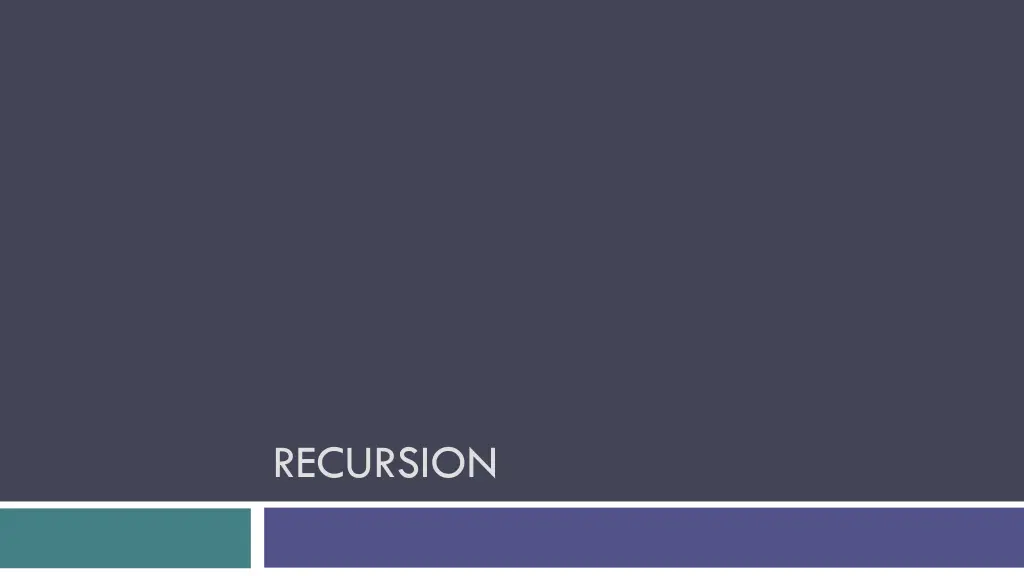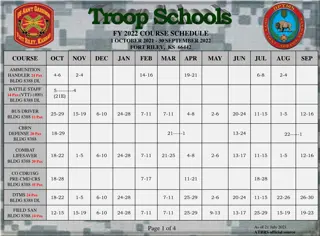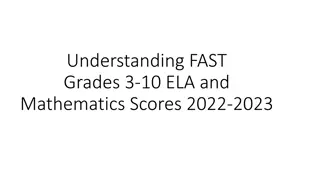
Understanding Recursion: Concepts and Examples
Explore the concepts of recursion versus iteration, efficiency of recursive methods, problem-solving with recursion, and a detailed look at the classic Towers of Hanoi puzzle. Learn about the similarities and differences between recursion and iteration, efficiency considerations, and dive into a recursive algorithm for the Towers of Hanoi problem. Discover the beauty and challenges of recursive algorithms in problem-solving scenarios.
Download Presentation

Please find below an Image/Link to download the presentation.
The content on the website is provided AS IS for your information and personal use only. It may not be sold, licensed, or shared on other websites without obtaining consent from the author. If you encounter any issues during the download, it is possible that the publisher has removed the file from their server.
You are allowed to download the files provided on this website for personal or commercial use, subject to the condition that they are used lawfully. All files are the property of their respective owners.
The content on the website is provided AS IS for your information and personal use only. It may not be sold, licensed, or shared on other websites without obtaining consent from the author.
E N D
Presentation Transcript
Recursion Versus Iteration There are similarities between recursion and iteration In iteration, a loop repetition condition determines whether to repeat the loop body or exit from the loop In recursion, the condition usually tests for a base case You can always write an iterative solution to a problem that is solvable by recursion (& vice-versa) A recursive algorithm may be simpler than an iterative algorithm and thus easier to write, code, debug, and read
Efficiency of Recursion Recursive methods often have slower execution times relative to their iterative counterparts The overhead for loop repetition is smaller than the overhead for a method call and return If it is easier to conceptualize an algorithm using recursion, then you should code it as a recursive method The reduction in efficiency usually does not outweigh the advantage of readable code that is easy to debug
Towers of Hanoi The Towers of Hanoi is a mathematical puzzle invented by the mathematician douard Lucas in the 19thcentury Move the three disks to a different peg, maintaining their order (largest disk on bottom, smallest on top, etc.) Only the top disk on a peg can be moved to another peg A larger disk cannot be placed on top of a smaller disk
Algorithm for Towers of Hanoi (cont.) Solution to Four-Disk Problem: Move Four Disks from Peg L to Peg R 1. Move the top three disks from peg L to peg M. 2. Move the bottom disk from peg L to peg R. 3. Move the top three disks from peg M to peg R.
Recursive Algorithm for Towers of Hanoi Recursive Algorithm for n -Disk Problem: Move n Disks from the Starting Peg to the Destination Peg ifn is 1 move disk 1 (the smallest disk) from the starting peg to the destination peg else move the top n 1 disks from the starting peg to the temporary peg (neither starting nor destination peg) move disk n (the disk at the bottom) from the starting peg to the destination peg move the top n 1 disks from the temporary peg to the destination peg
Implementation of Recursive Towers of Hanoi public static void hanoi(int n, char from, char to, char temp) { if( n == 1 ) System.out.println("Move disk from " + from + " to " + to); else { hanoi(n 1, from, temp, to); hanoi(1, from, to, temp); hanoi(n 1, temp, to, from); } }
Lessons from Tower of Hanoi The recursion is pretty interesting You can prove that there's no faster way to do it than the given approach But it's very slow! 64 disks would take longer than the Universe has been in existence, even on the faster modern computers How can we understand how long recursion takes? Take COMP 4500 to find out!
Recursive Data Structures Computer scientists often encounter data structures that are defined recursively each with another version of itself as a component Linked lists and trees can be defined as recursive data structures Recursive methods provide a natural mechanism for processing recursive data structures The first language developed for artificial intelligence research was a recursive language called LISP
Recursive Definition of a Linked List A linked list is a collection of nodes such that each node references another linked list consisting of the nodes that follow it in the list The last node references an empty list A linked list is empty, or it contains a node, called the list head, that stores data and a reference to a linked list
Node definition private class Node<E> { E data; Node<E> next; }
Backtracking Backtracking is an approach to implementing a systematic trial and error search for a solution An example is finding a path through a maze If you are attempting to walk through a maze, you will probably walk down a path as far as you can go Eventually, you will reach your destination or you won t be able to go any farther If you can t go any farther, you will need to consider alternative paths Backtracking is a systematic, nonrepetitive approach to trying alternative paths and eliminating them if they don t work
Backtracking (cont.) If you never try the same path more than once, you will eventually find a solution path if one exists Problems that are solved by backtracking can be described as a set of choices made by some method Recursion allows you to implement backtracking in a relatively straightforward manner Each activation frame is used to remember the choice that was made at that particular decision point A program that plays chess may involve some kind of backtracking algorithm
A Framework for Backtracking 24 We will develop a generic solution for backtracking that can be used in the context of any problem for which backtracking is a viable approach In this framework, the Application interface and the Backtrack class make up the primary abstractions. They can be used without modification for any backtracking project.
Application 25 import java.util.*; public interfaceApplication { // isOK returns true if pos is a legal position // and not a dead end booleanisOK (Position pos); // markAsPossible marks pos as possibly being on // a path to a goal position voidmarkAsPossible (Position pos); // isGoal returns true if pos is a goal position booleanisGoal (Position pos); // markAsDeadEnd marks pos as not being on a path // to a goal position. voidmarkAsDeadEnd (Position pos); // toString returns a string version of this Application. String toString(); // iterator returns an iterator over the position // directly accessible from pos. Iterator<Position> iterator (Position pos); }
Position Iterator 26 In any class that implements the Application interface, there will be an embedded iterator class with the usual methods: hasNext( ) and next( ).
Backtrack 27 import java.util.*; public class BackTrack { Application app; // stores reference to application in state variable public BackTrack (Application app) { this.app = app; } // returns true if a solution can be found from pos public boolean tryToReachGoal(Position pos) { //implementation developed on next slides } }
tryToReachGoal(pos) 28 The tryToReachGoal method: First construct an iterator from pos of all positions immediately accessible from pos. Then loop until success has been achieved or no more iterations are possible. Each loop iteration considers several possibilities for the new position, nextpos, generated by the iterator nextpos is a goal: return true Might be on path to goal: mark nextpos as possible, and then see if a goal can be reached from nextpos Yes? return true No? mark nextpos as dead end; (more) ? iterate : return false
public boolean tryToReachGoal (Position pos) { boolean success = false; Iterator<Position> itr = app.iterator (pos); while (!success && itr.hasNext()) { nextpos = itr.next(); if (app.isOK (nextpos)) { app.markAsPossible (nextpos); if (app.isGoal (nextpos)) success = true; else { success = tryToReachGoal (nextpos); if (!success) { app.markAsDeadEnd (nextpos); } } } } returnsuccess; }
Summary 30 The user of the Backtracking Framework needs to Provide a specific application that implements the Application interface Provide a class that defines what a position is in the current application A way to iterate from the current position to all of the possible next positions
Finding a Path through a Maze Problem Use backtracking to find a display the path through a maze From each point in a maze you can move to the next cell in a horizontal or vertical direction if the cell is not blocked
Finding a Path through a Maze (cont.) Analysis The maze will consist of a grid of colored cells The starting point is at the top left corner (0,0) The exit point is at the bottom right corner (getNCols() 1, getNRow -1) All unexplored cells will be CORRIDORcolor All cells that represent barriers will be WALLcolor Cells that we have visited will be DEAD_END color If we find a path, all cells on the path will be set to PATH color
Representation 33 Maze searching: 1 = Corridor 0 = Wall start 1 1 1 0 1 1 0 0 0 1 1 1 1 1 0 1 1 1 0 1 1 1 1 1 0 1 1 0 0 0 1 0 1 0 1 0 1 0 1 1 0 0 0 1 1 1 0 1 0 1 1 1 1 1 1 1 1 0 0 0 0 1 0 0 0 0 0 0 0 1 0 0 0 0 0 0 0 0 0 0 0 0 1 1 1 1 1 1 1 1 1 finish Iterator choices: north, west, south, east Marked as possible = 9; dead end = 2
Solution 35
Representation 36 Maze searching: 1 = Corridor 0 = Wall start 9 2 2 0 2 2 0 0 0 2 2 2 2 9 0 2 2 2 0 2 2 2 2 2 0 2 9 0 0 0 2 0 2 0 2 0 2 0 2 9 0 0 0 2 2 2 0 2 0 2 2 2 9 9 9 9 9 0 0 0 0 1 0 0 0 0 0 0 0 9 0 0 0 0 0 0 0 0 0 0 0 0 9 9 9 9 9 9 9 9 9 finish Iterator choices: north, west, south, east Marked as possible = 9; dead end = 2
Maze Position 37 public class Position { protected int row, column; public Position(int r, int c) { row = r; column = c; } public int getRow() { return row; } } public int getCol() { return column; }
Maze.java 38 public class Maze implements Application { protected final byte WALL = 0; protected final byte CORRIDOR = 1; protected final byte PATH = 9; protected final byte DEAD_END = 2; protected Position finish; protected byte[][] grid;
Maze.java 39 public boolean isOK(Position pos) { } if (pos.getRow() >= 0 && pos.getRow() < grid.length && pos.getCol() >= 0 && pos.getCol() < grid[0].length && grid[pos.getRow()][pos.getCol()] == CORRIDOR) { return true; } else { return false; }
MazeIterator.java 40 public class MazeIterator implements Iterator { private static final MAX_MOVES = 4; private int row, col, count; public MazeIterator(Position pos) { row = pos.getRow(); col = pos.getCol(); count = 0; } public boolean hasNext() { return count < MAX_MOVES; }
MazeIterator.java 41 public Position next() { Position pos = new Position(); switch (count++) { case 0: pos = new Position(row-1, col); break; case 1: pos = new Position(row, col-1); break; case 2: pos = new Position(row+1, col); break; case 3: pos = new Position(row, col+1); break; } } //NORTH //WEST //SOUTH //EAST
Recursive Algorithm for Finding Maze Path Recursive Algorithm for findMazePath(x, y) if the current cell is outside the maze return false (you are out of bounds) else if the current cell is part of the barrier or has been visited already return false (you are off the path or in a cycle) else if the current cell is the maze exit recolor it to the path color and return true (you have successfully completed the maze) else // Try to find a path from the current path to the exit: mark the current cell as on the path by recoloring it to the path color for each neighbor of the current cell if a path exists from the neighbor to the maze exit return true // No neighbor of the current cell is on the path recolor the current cell to the temporary color (visited) and return false






















